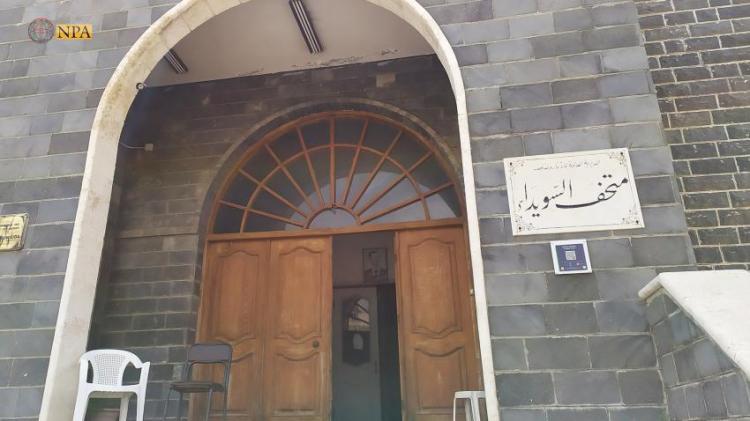As-Suwayda – NPA
The widespread ancient ruins in the of As-Suwayda southern Syria, suffer negligence and encroachment, especially in the red zone.
The archaeological area in the red zone contains buildings in the central street, starting from the northern gate of the city, passing through the Triumph Arch, known locally as “Mashnaqa”, to the small amphitheater.
While the central street has turned to a trade zone, as Firas R. told to North Press, expressing his surprise by the shift of the times, where restoration of houses in the area isn’t allowed.
Firas blamed the Department of Antiquities for “not preserving the historic buildings in the city, adding that “they build above monuments so that they remain exposed, and they don’t take the aesthetic characteristics of the buildings into consideration that in which should reflect the region’s identity.”
Question Marks
An activists interested in Archeology in As-Suwayda, who asked not to be named, told North-Press about the question marks on the paving of the central street in a particular archaeological area in mid-nineties last century, where “establishing modern buildings over scattered monuments in the region is allowed now, the matter raises questions about the reasons for erasing these ruins and depriving citizens of enjoying their real proceeds.”
The activist pointed out that the facts mentioned above is “done in a clear absence of enabling people to live in their houses or rehabilitating buildings with preserving cultural identity,” noting that, “the most important archaeological site in As-Suwayda contains the Grand Amphitheater which exceeds Bosra Al-Sham Amphitheater in its size, as well as the oldest churches in the Middle East”.
Violations and Laws
Sources from inside the Department of Antiquities, refused to disclose their identity for reasons related to the non-disclosure of any information to the media, denied in an interview with North-Press, the possibility of cases of ruins encroachment, claiming that “buildings are built according to the laws, and if there are some violations, they are a few and are being controlled by laws.”
The sources added: “There’re articles within the registration decision, that allow issuing permissions under specific terms according to the archaeological area segment in the red to the Blue Zone, we have a long-lasting problem, which is the lack of enough acquisitions, as many buildings have been left on their own property, and private properties are preserved, but those buildings remain bound to the city council’s approval, which in its turn is based on the Department of Antiquities approval.”
The mentioned sources pointed out that “within the current situation, the Directorate of Antiquities have succeeded in preserving the ruins by obligating the building’s owners to preserve them, but we also demand many acquisitions that will allow us to preserve the ruins.”
Furthermore, the sources padded that “The owners of legal licenses are obliged to rehabilitate the ruins within the specified terms, and to start building process far from the ruins, and to be allowed only to build two or three floors”.
On the other hand, these sources spoke about the good results in terms of preventing of erasing of the ruins, denying at the same time any decisions about “lifting real estate acquisitions despite the existence of foreclosures in front of the judiciary.”
The Antiquities’ Need for Protection
The Sources from inside the Directorate of Antiquities talked about the need to support the Antiquities in the proper way, stressing that the constant crossing of the heavy machinery on the central street will affect the rest of ruins.”
They also pointed out that “the least affected percentage of ruins is in As-Suwayda governorate, while compared to other governorates”, noting the absence of cleansing staff in the archaeological areas, while using workers from for the municipality instead.
The lack of civil engineers and architects in the Department of Antiquities, as well as proper funds to allow the Department to work effectively, leading to increased poor services.

